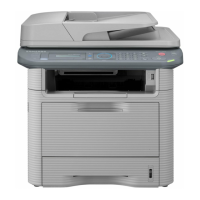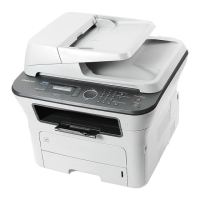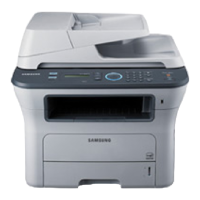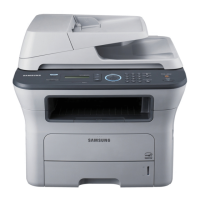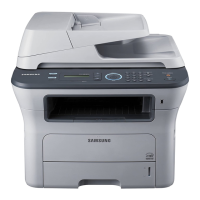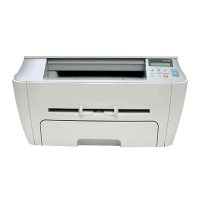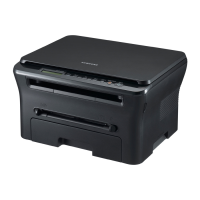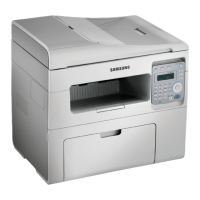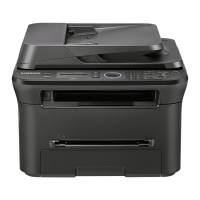Do you have a question about the Samsung SCX-4833FD and is the answer not in the manual?
Highlights environmentally friendly, high resolution, and convenient features of the machine.
Compares features and optional goods available for different machine models.
Explains the guide's purpose, conventions, and icons used throughout.
Provides crucial warnings and precautions for safe operation and to prevent potential damage.
Details the machine's accessories and provides front and rear views.
Explains the function of buttons and displays on various control panel types (A, B, C).
Provides steps for connecting the machine to electricity and powering it on.
Instructions for installing the printer driver on a Windows operating system.
Steps to uninstall and then reinstall the printer driver if issues arise.
Explains how to access and navigate the machine's menus for setup and functions.
Provides steps to change the language displayed on the control panel.
Information on loading print media into trays and the multi-purpose tray.
Instructions for performing basic printing tasks and canceling print jobs.
Steps for making basic copies and adjusting settings like darkness and contrast.
Procedures for scanning documents using the control panel or USB connection.
Guidance on preparing to fax, sending, and receiving faxes.
Instructions for using USB memory devices for scanning, printing, and management.
Information on how to order authorized supplies, accessories, and maintenance parts.
Lists available supplies such as toner cartridges and their approximate yields.
Details optional accessories like memory modules and additional trays.
Lists maintenance parts and their average yields for replacement.
Temporary fix for print quality issues by redistributing toner within the cartridge.
Step-by-step guide on how to replace the toner cartridge.
Instructions for installing additional memory modules (DIMMs) into the machine.
How to check page counts for supplies like toner and document feeder usage.
Configuration options for toner low alert messages and LEDs.
Procedures for cleaning the machine's exterior, interior, rollers, and scan unit.
Guidelines to prevent paper jams by using correct media and loading techniques.
Steps to remove jammed originals from the document feeder and scanner paths.
Instructions to clear paper jams from various trays and internal areas of the machine.
Explains the meaning of different LED colors and blinking patterns indicating machine status.
Lists common error messages on the control panel and their suggested solutions.
Lists general specifications, including dimensions, weight, and power consumption.
Provides laser safety, ozone safety, mercury safety, power saver, and disposal information.
Contains legal information regarding copyright and trademarks.
Highlights environmentally friendly, high resolution, and convenient features of the machine.
Compares features and optional goods available for different machine models.
Explains the guide's purpose, conventions, and icons used throughout.
Provides crucial warnings and precautions for safe operation and to prevent potential damage.
Details the machine's accessories and provides front and rear views.
Explains the function of buttons and displays on various control panel types (A, B, C).
Provides steps for connecting the machine to electricity and powering it on.
Instructions for installing the printer driver on a Windows operating system.
Steps to uninstall and then reinstall the printer driver if issues arise.
Explains how to access and navigate the machine's menus for setup and functions.
Provides steps to change the language displayed on the control panel.
Information on loading print media into trays and the multi-purpose tray.
Instructions for performing basic printing tasks and canceling print jobs.
Steps for making basic copies and adjusting settings like darkness and contrast.
Procedures for scanning documents using the control panel or USB connection.
Guidance on preparing to fax, sending, and receiving faxes.
Instructions for using USB memory devices for scanning, printing, and management.
Information on how to order authorized supplies, accessories, and maintenance parts.
Lists available supplies such as toner cartridges and their approximate yields.
Details optional accessories like memory modules and additional trays.
Lists maintenance parts and their average yields for replacement.
Temporary fix for print quality issues by redistributing toner within the cartridge.
Step-by-step guide on how to replace the toner cartridge.
Instructions for installing additional memory modules (DIMMs) into the machine.
How to check page counts for supplies like toner and document feeder usage.
Configuration options for toner low alert messages and LEDs.
Procedures for cleaning the machine's exterior, interior, rollers, and scan unit.
Guidelines to prevent paper jams by using correct media and loading techniques.
Steps to remove jammed originals from the document feeder and scanner paths.
Instructions to clear paper jams from various trays and internal areas of the machine.
Explains the meaning of different LED colors and blinking patterns indicating machine status.
Lists common error messages on the control panel and their suggested solutions.
Lists general specifications, including dimensions, weight, and power consumption.
Provides laser safety, ozone safety, mercury safety, power saver, and disposal information.
Contains legal information regarding copyright and trademarks.
| Duplex printing | Yes |
|---|---|
| Print technology | Laser |
| Maximum resolution | 1200 x 1200 DPI |
| Time to first page (black, normal) | 6.5 s |
| Print speed (black, normal quality, A4/US Letter) | 31 ppm |
| Dimensions (WxDxH) | 424 x 382 x 407 mm |
| Networking features | Fast Ethernet |
| All-in-one functions | Copy, Fax, Print, Scan |
| Color all-in-one functions | No |
| Maximum duty cycle | 50000 pages per month |
| Copier resize | 25 - 400 % |
| Maximum number of copies | 99 copies |
| N-in-1 copy function (N=) | 2, 4 |
| Time to first copy (black, normal) | 12 s |
| Copy speed (black, normal quality, A4) | 31 cpm |
| Scan to | E-mail, File, USB |
| Maximum scan resolution | 4800 x 4800 DPI |
| Faxing | Mono faxing |
| Fax memory | 260 pages |
| Modem speed | 33.6 Kbit/s |
| Fax resolution (black) | 300 x 300 DPI |
| Paper input type | Cassette |
| Total input capacity | 250 sheets |
| Total output capacity | 150 sheets |
| Maximum input capacity | 350 sheets |
| Total number of input trays | 1 |
| Maximum number of input trays | 3 |
| Auto document feeder (ADF) input capacity | 50 sheets |
| Maximum print size | 216 x 356 mm |
| Paper tray media types | Bond paper, Card stock, Envelopes, Labels, Plain paper, Pre-Printed, Recycled paper, Thin paper, Transparencies |
| ISO A-series sizes (A0...A9) | A4, A5, A6 |
| Maximum ISO A-series paper size | A4 |
| Display | LCD |
| Market positioning | Business |
| Display number of lines | 2 lines |
| Standard interfaces | Ethernet, USB 2.0 |
| USB 2.0 ports quantity | USB 2.0 ports have a data transmission speed of 480 Mbps, and are backwards compatible with USB 1.1 ports. You can connect all kinds of peripheral devices to them. |
| Internal memory | 128 MB |
| Processor family | Samsung |
| Maximum internal memory | 384 MB |
| Sound power level (standby) | 26 dB |
| Sound pressure level (copying) | 54 dB |
| Sound pressure level (printing) | 53 dB |
| Power consumption (average operating) | - W |
| Linux operating systems supported | CentOS 5.1, CentOS 5.2, Fedora 11, Fedora 6, Fedora 7, Fedora 8, Fedora 9, RedHat EL Linux 4.0 U5, RedHat EL Linux 4.0 U6, RedHat EL Linux 4.0 U7, RedHat EL Linux 5.0, SuSE Linux 10, Ubuntu 10.04, Ubuntu 8.04, Ubuntu 8.10, Ubuntu 9.04, Ubuntu 9.10 |
| Server operating systems supported | Windows Server 2003, Windows Server 2003 x64, Windows Server 2008, Windows Server 2008 R2, Windows Server 2008 x64 |
| Windows operating systems supported | Windows 2000, Windows 2000 Professional, Windows 7 Home Premium, Windows 7 Home Premium x64, Windows 7 Professional, Windows 7 Professional x64, Windows 7 Starter, Windows 7 Starter x64, Windows 7 Ultimate, Windows 7 Ultimate x64, Windows Vista Business, Windows Vista Business x64, Windows Vista Home Basic, Windows Vista Home Basic x64, Windows Vista Home Premium, Windows Vista Home Premium x64, Windows Vista Ultimate, Windows Vista Ultimate x64, Windows XP Home, Windows XP Home x64, Windows XP Professional, Windows XP Professional x64 |
